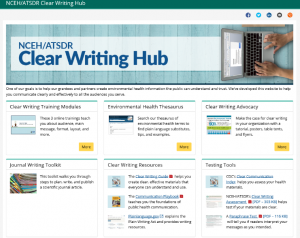Welcome to CDC’s NCEH/ATSDR Clear Writing Hub!
Posted on by
Part 3: Tools for writing a scientific journal article
Share Your Knowledge: Write a Scientific Journal Article
Our NCEH/ATSDR blog, “Your Health, Your Environment,” reaches a varied audience. Whether you want to know more about our programs, get to know our scientists, or learn something new about environmental health, you can find a post to meet that need. Blog readers range from non-scientific audiences to scientists and health providers.
Recently, we’ve published a three-part series about our Clear Writing Hub. This third post in the series is aimed toward our scientific readers. Have you considered writing a scientific journal article on your specific field or area of study? If so, we recommend the last section of the Hub: Writing a Scientific Journal Article. This section takes writers from developing and clearing the concept to final publication.
Authors can use one of several ways to approach writing a journal article. Although this approach is rather prescriptive, it can be helpful for people who don’t know where to start or who are having trouble getting published in their journal of choice. However, since all of us can improve our writing skills, this section can be helpful for experienced journal authors as well. Some of you may even want to become a science writer for the public. Learning a new writing style presents the opportunity to broaden your viewpoint as well as your audience.
Write to inform, not impress.
Most journal authors are anxious to share their discoveries, but some seem to focus on proving how brilliant they are. Of course, all of us hope our readers view us as a credible source, but for some academic writers, impressing their readers appears to be the main purpose. However, if readers are turned off by that tone or find your style cumbersome to read, your amazing ideas will never be heard.
The Elsevier publication, Elements of Style for Writing Scientific Journal Articles, says the most important rule for writing scientific journal articles is “Write for the busy reader who is easily distracted.” The authors know that most readers (including or especially scientists) have little time to penetrate the full contents of an article. Readers will use almost any excuse to stop reading, particularly when encountering poor writing that leads to reader fatigue and frustration.
Your job as a writer is to communicate information and knowledge in a compelling and well-written manner. We recommend making each sentence, paragraph, subsection, section, figure, etc. coherent and easily digestible nuggets of information.
Learn the steps in writing a journal article.
Our Toolkit for Preparing and Writing Scientific Journal Articles takes you through each step in researching, writing, responding to reviewers, and submitting your article to the chosen journal.
Step 1: Prepare!
Of course, the first step in any writing project is preparation. Planning ahead will save you time in the long run and make your article stronger.
We recommend getting concept clearance from your team lead before you start writing. This chapter features a worksheet for authors to help you narrow down the purpose of your article, identify the knowledge gaps in existing research, and determine your audience. It provides an orderly way to capture your thoughts before you begin putting them on paper.
Step 2: Choose a publication
The second chapter will guide you in choosing the best journal for your article. It is still under development, but we expect to post it on the Hub soon. Watch for it!
Step 3: Write!
The third step is to start writing. This section takes you through writing the specific parts of a scientific journal article: your abstract and introduction, the methods and results section, and the discussion, which includes the conclusions of your study. It suggests the number of paragraphs for each section and the number of sentences for each paragraph and offers examples. This step also guides you in choosing a direct and concise title and writing your reference section.
Step 4: Solicit reviews!
Section four helps you navigate the reviews (and reviewers!) of your article. Since you know what you intended to write in your paper, it is sometimes difficult to put yourself in the position of a reader. You can often improve your paper by asking colleagues to read it and give you their feedback. Some reviewer feedback will show you clear ways to improve your work. Some might be less helpful. The toolkit reminds you to think carefully about which reviewers to choose and which reviewer suggestions will really strengthen your article.
For future reference and to keep the journal toolkit on hand, you can download it from the site, along with a tip sheet on clear writing practices.
Use the toolkit!
Remember that scientific writing does not need to be technical, boring, and hard to understand. Regardless of whether you are writing a lengthy report, a peer review, or an abstract, the objective remains the same— to find the most direct path connecting your main message(s) to your reader. This path is shortest and most unobscured when writing is clear, concise, and cohesive. Use our toolkit to write your next journal article.
Tweet this: “Check out CDC’s Clear Writing Hub for clear writing support! Go to https://bit.ly/2W5bF5s.”
Post a Comment